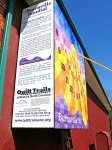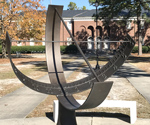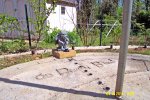North Carolina
| |
 |
Asheville |
North Carolina |
USA |
Analemmatic Dial |
Dial 731 |
| A 16 foot major axis analemmatic dial with stained concrete, hand painted date line. Hemlock branch hour posts were cut by Estate foresters and use iron numerals hand-forged by the Estate blacksmith. |
| |
| |
 |
Burnsville |
North Carolina |
USA |
Vertical Dial |
Dial 676 |
| The Quilt Block Sundial, an 8x8 foot painted wood nearly-south facing vertical dial with a steel gnomon rod. Dial face consists of a bold quilt block pattern and includes Arabic hour numerals for local solar time, EST and EDT. Hour lines are corrected for longitude and EOT correction is provided by the profile of purple hills along the bottom of the dial. The star map at the top of the dial represents the starry sky at the first sunrise over the newly formed Yancy County on December 29, 1833. The dial declines 3deg west of south. A 3 foot thick steel frame locates dial away from wall to clear roof overhang. |
| |
| |
 |
Chapel Hill |
North Carolina |
USA |
Horizontal Dial |
Dial 101 |
| A 35 foot diameter horizontal dial of terrazzo with inset bronze hour lines and Roman hour numerals. The bronze gnomon edge is 24 feet long and at the tip stands 14 feet tall. In the base of the gnomon is a circular opening, holding a large inset bronze hour glass. In the terrazzo at the dial center is an inset bronze sun graphic with wavy spicules; this inset contains a US Coast and Geodetic Survey Triangulation Station marker. A plaque gives correction for EOT and longitude. |
| |
| |
 |
Durham |
North Carolina |
USA |
Noon Mark or Meridian Dial |
Dial 356 |
| Called "Gnomon", this large sculpture consisting of two monoliths made of steel-reinforced concrete slabs laid nearly next to each other along one edge. This produces a thin slit between them,with both leaning against a third slab. If one could look down on this from an airplane, it appears as an arrowhead pointing south. At local noon, sunlight passing through the slit falls on the edge of the third slab. |
| |
| |
 |
Gastonia |
North Carolina |
USA |
Horizontal Dial |
Dial 649 |
| A 56 inch horizontal dial of stone masonry with wrought iron gnomon. Dial center filled with crushed rock with Roman numerals on perimeter stones. Dial is longitude corrected to EST and the EOT correction is shown on an adjacent landscape stone.
Dial is on private property but can be seen from the public street. For closer viewing, contact owner. |
| |
| |
|
Greensboro |
North Carolina |
USA |
Equatorial Dial |
Dial 277 |
| 33 ft. Bronze Sundial consisting of two intersecting semi-spherical arcs. Gift of the Greensboro Council of Garden Clubs, 1981. Mounted atop a 12 sided granite base. |
| |
| |
 |
Kannapolis |
North Carolina |
USA |
Horizontal Dial |
Dial 703 |
| A large horizontal cast concrete dial on a brick patio. Dial face includes hour lines and Roman numerals. Dial is dedicated as a tribute to the men and women of Kannapolis who died while serving in the US armed forces. |
| |
| |
 |
Mars Hill |
North Carolina |
USA |
Armillary Sphere |
Dial 1133 |
| This simple stainless steel armillary is called the "TimeKeeper Sundial" is approximately 20 inches (51cm) in diameter with meridian circle and equatorial timekeeping circle. The gnomon is a classic arrow rod. The hexagon stainless steel pedestal has six medallions at the top with medial motifs. |
| |
| |
 |
Marshall |
North Carolina |
USA |
Armillary Sphere |
Dial 642 |
| An armillary steel ring equatorial dial approximately 4 feet diameter. Hour ring has Roman numerals cut through the ring to show EST. Mounted on a concrete pedestal marked with city name and builder's mark. The pedestal is also marked with Marshall town map coordinates 35.79° N, 82.68° W, which are not the precise coordinates of the dial. Weathered finish is green enamel paint on steel. The concrete pedestal is marked with Marshall city name, builder's mark and approximate coordinates. |
| |
| |
 |
Raleigh |
North Carolina |
USA |
Horizontal Dial |
Dial 864 |
| Known as the Primrose Sundial, the bronze dial plate is a little more than a foot in diameter and sits on a small stone pillar about four feet high. The dial has simple hour lines from 4am to 8pm marked on the hour in Roman numerals. The open bronze gnomon is about 1/2 inch thick, held by both tenon and two large screws. |
| |
| |
 |
Waynesville |
North Carolina |
USA |
Horizontal Dial |
Dial 1116 |
| This is a large horizontal sundial 5-feet (1.5m) in diameter with a twist. The dial is made of aluminum and set on a circular concrete dais several inches above ground level. Hour lines of thin aluminum rods extend from 9am to 3pm using Roman numerals. The gnomon is a braced aluminum rod that creates a sleek, modern looking sundial. But the twist is the dial face can be slightly rotated to accommodate the equation of time (EoT). Above the solar noon pointer is a small scale for the rotation offset. |
| |
| |
 |
Wilmington |
North Carolina |
USA |
Equatorial Dial |
Dial 852 |
| This is a bronze hemispherical equatorial sundial approximately 30 inches in diameter. The wide equatorial band is delineated every quarter hour and has cast Arabic numerals as hour markers from 6am to 6pm. The meridian band is inscribed with markers for the solstices and cross-quarter days. |
| |
| |
 |
Winston-Salem |
North Carolina |
USA |
Analemmatic Dial |
Dial 709 |
| A 23.5 foot major axis analemmatic dial with a 10 foot tall movable steel vertical gnomon. Hours are marked by numerals on solar-powered lamps on the ellipse at the perimeter bush line. The concrete dial face consists of an 8 foot dais that displays the EOT and hosts a handsome gargoyle.
This private dial is available for viewing by contacting the owner. |
| |